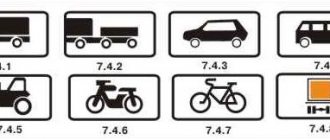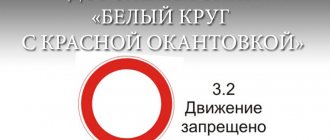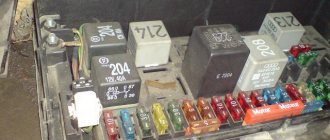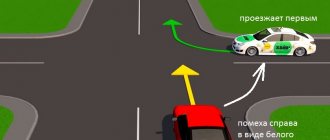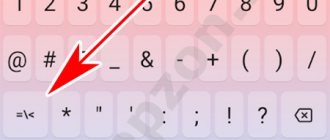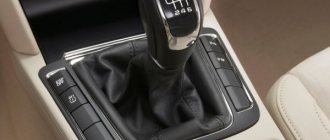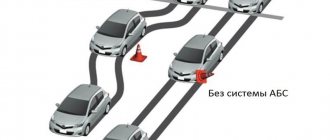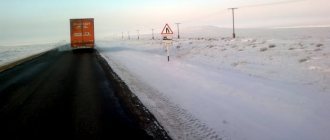Good afternoon, dear reader.
This article will consider mandatory traffic signs , which are the subject of Part 4 of Appendix 1 to the Traffic Regulations. Just like the previously discussed prohibiting road signs, a driver can violate the requirements of mandatory road signs, for which the Code of Administrative Offenses of the Russian Federation 2022 and 2022 provides for penalties ranging from small fines to deprivation of a driver’s license.
So, today we will consider the following prescriptive signs: moving straight, moving right, moving left, moving straight or to the right, moving straight or left, moving right or left, going around an obstacle on the right, going around an obstacle on the left, going around an obstacle on the right or left.
List of previously published articles in the “Traffic Signs” series:
- Warning road signs.
- Signs: pedestrian crossing, beware of children, slippery road, speed bump.
- Signs: road works, wild animals, traffic jams, other dangers.
- Priority signs: main road, give way, driving without stopping is prohibited.
- Prohibiting traffic signs: traffic is prohibited, entry is prohibited.
- Signs: pedestrians are prohibited, bicycles are prohibited, and trailers are prohibited.
- Signs for height restrictions, weight restrictions, length restrictions.
- Signs: U-turn prohibited, left turn prohibited, right turn prohibited.
- No overtaking signs, no sound signal, maximum speed limit.
- No parking signs, no parking on odd days of the month, no parking on even days of the month.
Go straight ahead sign
sign requiring allows the driver to move only in the straight direction:
Please note that this sign prohibits traffic in all other directions.
Features of the straight ahead sign:
- If it is installed at an intersection, then its effect applies only to the intersection of roadways in front of which it is installed.
- If a sign is installed outside an intersection, its effect extends to the nearest intersection. However, it is not prohibited to turn right to enter the adjacent territory.
- Route vehicles have the right not to comply with the requirements of this sign.
Please note that a straight ahead sign can be installed, for example, in a gap in the dividing strip, to prevent vehicles from turning left and turning around.
Please note that violating the requirements of this sign may result in your vehicle ending up on a one-way road and moving there in the opposite direction. Naturally, this is quite dangerous, and such a maneuver is punishable by deprivation of rights.
Mandatory signs
As a rule, prescriptive signs are made in the shape of a circle. Pictograms are most often depicted on a dark blue background. They allow traffic: “arrows” before crossing roads, a sign indicating the entrance to a roundabout, signs indicating pedestrian or bicycle paths.
Prescriptive signs do not impose restrictions, but, on the contrary, require the performance of a specific maneuver: they show the direction, speed and type of transport that can continue moving.
Also read: How to learn to drive a car from scratch
Right or left traffic sign
Sign 4.1.6 “Moving right or left” allows you to make a U-turn, turn left and turn right:
The only direction you can't move is straight.
Let's consider the characteristic features of all of the above prescriptive signs (4.1.1 - 4.1.6):
- They apply only to the intersection of roadways in front of which they are installed.
- They do not apply to public transport.
- Signs may use other arrow configurations to suit a specific roadway intersection.
Penalties for violating signs 4.1.1 - 4.1.6 completely depend on which points of the traffic rules will be additionally violated:
1. If the driver simply violates the requirement of a road sign, then he will be fined in the amount of 500 rubles.
For example, when leaving a yard on a two-lane road without markings, a sign “Move to the left” is installed, and the driver turns right.
2. If the driver turns left or makes a U-turn in a place where this is prohibited by one of the above signs, he will be fined 1,000 - 1,500 rubles.
For example, this can happen when making a U-turn at an intersection where there is a “Move to the right” sign.
3. If the driver, having violated the requirements of any of the above signs, ends up in the lane for fixed-route vehicles, then he will be fined 1,500 rubles (3,000 rubles in Moscow and St. Petersburg).
4. If, after violating a road sign, you enter a one-way road, then the driver will either be fined in the amount of 5,000 rubles, or he will be deprived of his driver’s license for a period of 4 to 6 months.
A complete list of fines for violating traffic rules can be found on the traffic police fine table page for 2021 and 2022.
Information signs
Information signs include blue squares indicating permitted turns, a parking sign, underground pedestrian crossings, signs indicating dead ends, traffic patterns, etc. In addition, these are also signs with the names of cities, villages and streets. In cities they are made in black letters on a white background, on highways - white letters on blue, and on highways - white on green.
Also read: Rules for retaking the traffic police exam
Non-alternative signs
Sign 4.1.2 “Move to the right” indicates movement along the path prescribed by the arrow (to the right).
For example, gas stations are equipped with this symbol to ensure the safe movement of a car entering busy highways and highways. The functioning of the arrow contains nuances:
- You should turn right from the far right lane of the road.
- The symbol is installed before the intersection.
- Action - only at the first fork in the road.
- Not required for route transport.
The last point is especially worth remembering for inexperienced drivers who are repeating the maneuvers of the vehicle in front. Such imitation constitutes a gross offense and a danger of causing an accident. The fine for ignoring a mandatory symbol is set at 1,000 – 1,500 rubles.
Signpost 4.1.3 “Move to the left” determines the route of movement of the vehicle according to the image of the arrow (to the left). The symbol is mounted before the fork in the road and loses its force immediately after it. You should know that a left turn maneuver does not exclude a U-turn.
Sign 4.2.1 “Avoiding an obstacle on the right” gives an idea of how to go around an obstacle (on the right).
The prescriptive nature of the symbol helps to stabilize the road situation when:
- carrying out repair or cleaning work;
- activation of the dividing strip;
- the appearance of a safety island and other things.
If it is possible to go around an obstacle on the left, the driver is not recommended to do this in order to avoid an accident and a fine.
The symbol operates in the area where an object is located that impedes movement. After passing the obstacle, you should return to your lane and drive as usual. Typically, motorists try to avoid obstacles on the right without leaving their lane. But sometimes conditions arise that prevent safe detour. In these cases, the solution to the problem of passing the obstacle is to install the sign 4.2.2 “Avoiding the obstacle on the left.”
The symbol instructs you to go around obstacles on the left edge; accordingly, if it is possible to go around them to the right, this should not be done.
Often, the symbol is equipped with vehicles of municipal and road services responsible for the improvement of streets: repair and cleaning activities, watering of plantings along highways and streets. Sometimes the prescription contradicts the markings, represented by a solid or double solid line. Then one must adhere to the principle of advantage, that is, follow the instructions of the symbol.
The designation “Detour on the left” does not give privileges to the driver in front of vehicles traveling on the opposite path.
Sign 4.1.1 “Move straight” Sign 4.1.2 “Move right” Sign 4.1.5 “Move straight or right”
These signs are much more common in the city than prohibitory signs. It may seem strange, but they will be stricter. It’s better to remember this: where the arrows in the round sign on a blue background point, that’s where we’re going.
Prohibit left turns and U-turns. Allow movement only straight, only right, straight or right.
Signs 4.1.3 “Move left” and 4.1.4 “Move straight and left”
And once again: where the arrow in the round sign on a blue background points, that’s where we’re going. Moreover, if this sign allows a left turn, it also allows a U-turn.
Allows left turns and U-turns
Sign 3.19 “No U-turn”
The sign, as in the case above, is also obvious. But because the U-turn is prohibited, many people think that it also prohibits left turns. This is wrong. Remember: prohibition signs impose certain restrictions on movement, i.e. only in the indicated directions! This sign does not prohibit left turns.
Prohibits a turn Allows a left turn
5.11.1 "Turning space"
We can find this sign in places where we can turn around. But often there is a passage opposite the turning area (the entrance to a yard or a gas station), and drivers take advantage of this - they can make a U-turn, which means they can also turn. No! The traffic rules in this case only allow a U-turn! It's easy to remember: you are only allowed to move in the indicated direction.
Allows a turn Prohibits left turns
How to avoid punishment
You can try to avoid the fine. This is not easy to do, but it is possible. If you carefully study the traffic rules, then in addition to the installed signs, there should be appropriate markings in the areas. They are the ones who can help you get out of the situation.
When the markings are almost invisible, no one can punish you for violating them. This is especially true in cases where there is no “Go straight ahead” sign. The Plenum of the Supreme Court of the Russian Federation even once gave its comment on this issue. And it sounds like this: “No markings - no punishment.”
Perhaps this is the only case when a driver has a real opportunity to avoid a fine for turning in the wrong place. To be on the safe side, you can install a DVR in your car. After all, traffic police officers often insist that drivers violate the rule of the “Go straight ahead” sign and turn around/turn in places other than where it is permitted.
Now we understand the next road sign. And all the nuances of his work too. Pay attention to road markings and sign position. This will help you decide exactly how to behave when driving a car. In any case, the “Go Straight” rule is easier to comply with than many other restrictions. The main thing is to know about all the nuances of the location of the corresponding sign.
What is provided for lane violators when driving outside of their lane?
A driver who turns around at the intersection of these same lines is subject to a fine, according to Art. 12.16 h. 1 Code of Administrative Offences. This law states that violation of the requirements of road signs or highway markings is fraught with a warning or a fine equal to five thousand rubles.
At the same time, road signs and horizontal markings sometimes even contradict each other. In order not to get confused or lost in such cases, you should remember that road signs, even those installed temporarily, are even more important to follow than the markings. In addition, temporary markings have exactly the same advantage over permanent markings as signs have over markings in general.
Road signs have an advantage over road markings
Also, as an example of how diverse the system of administrative penalties on the roads is, we present three prohibitory signs.
| Sign number | Name |
3.18.1 | No right turns allowed |
3.18.2 | No left turn allowed |
3.19 | U-turn prohibited |
Little tricks for avoiding a fine
A fine for violating sign 4.1.1 is almost inevitable if this rule is violated, but “almost” and “completely” are different concepts. In order to have at least a small chance of avoiding punishment for a given traffic violation, it is necessary, first of all, to carefully study them. Or simply memorizing small tricks that we will describe here.
In addition to road signs, there are also road markings. However, in reality it is often simply erased, which makes it difficult to notice. It is this “erasure” that can prevent a traffic police officer from fining a driver. If the markings on the road are almost invisible, the traffic police officer does not have the right to fine the driver. Moreover, this works most of all when sign 4.1.1 is not visible. For example, it is hidden by tree branches. But in the case when the sign and markings are clearly visible, the traffic police officer usually has the right to fine the driver.
If the markings are poorly visible, you can avoid a fine
However, among them there are those who use illiteracy of drivers for illegal fines. For example, the “Go straight” sign allows you to turn into an adjacent area - into a yard, a gas station or another similar area. In this case, the traffic inspector does not have the right to fine the driver. And if such an attempt is made, the driver can simply remind him of this.
Signs 2.6 “Give way to oncoming traffic” and 2.7 “Take advantage of oncoming traffic”
Signs 2.6 and 2.7 do not refer to turns or U-turns, these are priority signs that indicate on a narrow section of the road who should give way to whom. Due to similar names and arrows, confusion arises - who should give in to whom here? In addition, they are rare, you can simply forget their meaning.
Easy to remember: a sign in a red circle usually indicates that something is prohibited. Right? If you see him, stop to let oncoming cars pass.
If it's blue, the road is yours.
Good luck on the roads!
In which directions are you allowed to continue driving?
| 1. | ? | Only to the left. |
| 2. | ? | Only in the opposite direction. |
| 3. | ? | To the left and in the opposite direction. |
An additional section with a green arrow signal on, a “Lane Directions” sign and marking 1.18 allow you to turn left or make a U-turn from the left lane.
End of minimum speed limit zone
Sign 4.7 signals the end of the activity of symbol 4.6 and returns the ability to move at convenient speed values. It is installed at the end of a section of highway or lane before the end of the minimum speed regulation space. Typically, the designation 4.7 is relevant on highway turns and climbs that limit visibility for the motorist.
And the last point that every car enthusiast should know: mandatory signs are often used together with various symbols of additional information in the form of signs that clarify or limit the effect of these signs. Therefore, such pointers must be read together.
Post Views: 21
Service marks
Service markers show where the nearest service station, gas station or rest area is located. Within the city they are installed directly next to the object, and on highways - from 400 m to several tens of kilometers. There are also signs indicating gas stations with sockets for electric cars.
Also read: Traffic controller signals in simple language
Installation after an intersection
If the mark is located outside the intersection, it takes on a slightly different meaning. A sign in this area states that after crossing the road lanes, the driver has no right to turn around and turn left. At the same time, he has access to some maneuvers:
- driving in reverse;
- travel in a straight line;
- turn right to enter adjacent areas adjacent to the roadway (yard of a multi-storey building, gas station or car wash area).
The signal coverage extends to the next intersection. If there is no similar mark after it, the driver can perform previously prohibited maneuvers, namely a U-turn and a turn to the left.
If the driver sees 4.11 in front of him, located after the intersection, he needs to remember the turn signals when exiting the main road onto a secondary one. Sometimes the sign allows driving in reverse, provided that this maneuver does not create obstacles to surrounding traffic.
The ban on certain maneuvers applies until the next intersection. As soon as the area of responsibility of the sign has ended, the driver is obliged to drive in accordance with the current traffic rules, unless there are other warning or prohibition signs.
Roundabout Circulation
Sign 4.3 “Roundabout” notifies the beginning of a traffic circle:
- when entering the ring, you must slow down the pace of movement;
- movement around the ring occurs exclusively counterclockwise;
- a turn is performed after driving a full circle;
- before the beginning of the roundabout, in addition to symbol 4.3, there are often signs 2.4 “Give way” or 2.5 “Driving without stopping is prohibited”;
- on a ring equipped with traffic lights, participants move according to the permitting signals.
A roundabout looks safer than a traditional one due to the lack of direct intersection of traffic flows. However, accidents happen here too. This happens, first of all, due to ignorance of the principle: the ring is almost always the main road. Some motorists, when entering the roundabout, believe that traffic moving in a circle should let them through, because they are an obstacle to it on the right.
Approaching a roundabout requires the driver to adhere to the posted speed limit, evaluate the symbols present, and follow the traffic rules around the roundabout.
Minimum speed limit
Sign 4.6 makes it possible to move at a speed not less than the prescribed speed, but not exceeding the permissible traffic rules.
The requirement is relevant for highways with heavy traffic flow, a long overtaking ban and a high probability of congestion:
- The symbol is often combined with other signs, for example, with a sign 8.4 “Traffic lane”, indicating a lane that allows movement at a prescribed pace.
- The use of the sign is legal when there is a nearby road or lane that duplicates the main one. This condition is associated with the movement of low-speed equipment, which can create a traffic jam on the way.
The minimum flow speed is also indicated by the sign 5.15.3 “Start of lane”.
Coverage area
Any road sign has a beginning and an end to its effect, that is, a certain area to which it applies. This also applies to the “go straight ahead” sign; its zone is determined based on general rules, depending on the location:
- if installed outside a road intersection, then it is valid until the next intersection;
- if installed immediately before an intersection, it extends to the first intersection.
If it is necessary to extend the coverage area, the sign is duplicated.
Sign 3.18.2 “Left turn prohibited”
It’s easy to remember: if the sign is in a red circle, then it is prohibitive. If the red line crosses out the direction, it’s all the more clear that you can’t go there. But many do not know that it has nothing to do with turning around and only prohibits left turns, and nothing else.
Prohibits left turns Allows turns
